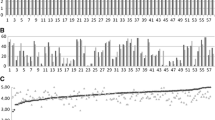Abstract
BACKGROUND: Most studies of effective inpatient teaching have focused on teaching by attending physicians.
OBJECTIVE: To identify and compare medical students’ perceptions of behaviors associated with teaching effectiveness of attending physicians and housestaff (residents and interns).
DESIGN AND PARTICIPANTS: Third-year students who spent 4 weeks on a general internal medicine inpatient service during academic year 2003–2004 completed surveys using a 5-point Likert-type scale. Students evaluated numerous teaching behaviors of attendings and housestaff and then evaluated their overall teaching effectiveness.
MEASUREMENTS: Each behavior was correlated with the perceived teaching effectiveness in univariate and regression analyses.
RESULTS: Seventy-two students were taught by 23 attendings and 73 housestaff. Of 144 possible teaching evaluations, they completed 142 (98.6%) for attendings and 128 (88.9%) for housestaff. The mean rating for perceived teaching effectiveness was 4.48 (SD 0.82) for attendings and 4.39 (SD 0.80) for housestaff. For attending physicians, teaching effectiveness correlated most strongly with enthusiasm for teaching (R2=63.6%) but was also associated with inspiring confidence in knowledge and skills, providing feedback, and encouraging students to accept increasing responsibility. Housestaff teaching effectiveness correlated most strongly with providing a role model (R2=61.8%) but was also associated with being available to students, performing effective patient education, inspiring confidence in knowledge and skills, and showing enthusiasm for teaching. Regression models explained 79.7% and 73.6% of the variance in evaluations of attendings and housestaff, respectively.
CONCLUSIONS: Students’ perceptions of effective teaching behaviors differ for attending physicians and housestaff, possibly reflecting differences in teaching roles or methods.
Similar content being viewed by others
References
Stern DT, Williams BC, Gill A, et al. Is there a relationship between attending physicians’ and residents’ teaching skills and students’ examination scores? Acad Med. 2000;75:1144–6.
Griffith CH, Wilson JF, Haist SA, Ramsbottom-Lucier M. Do students who work with better housestaff in their medicine clerkships learn more? Acad Med. 1998;73:S57–60.
Roop SA, Pangaro L. Effect of clinical teaching on student performance during a medicine clerkship. Am J Med. 2001;110:205–9.
Griffith CH, Georgesen JC, Wilson JF. Specialty choices of students who actually have choices: the influence of excellent clinical teachers. Acad Med. 2000;75:278–82.
Irby DM. Three exemplary models of case-based teaching. Acad Med. 1994;69:947–53.
Irby DM. What clinical teachers in medicine need to know. Acad Med. 1994;69:333–42.
Torre DM, Sebastian JL, Simpson DE. Learning activities and high-quality teaching: perceptions of third-year IM clerkship students. Acad Med. 2003;78:812–4.
Elnicki DM, Kolarik R, Bardella I. Third-year medical students’ perceptions of effective teaching behaviors in a multidisciplinary ambulatory clerkship. Acad Med. 2003;78:815–9.
Barnard K, Elnicki DM, Lescisin DA, et al. Students perceptions of the effectiveness of interns’ teaching during the internal medicine clerkship. Acad Med. 2001;76:S8–10.
Bordley DR, Litzelman DK. Preparing residents to become more effective teachers: a priority for internal medicine. Am J Med. 2000;109:694–6.
Goroll AH, Morrison G, Bass EB, et al. Reforming the core clerkship in internal medicine: the SGIM/CDIM project. Ann Intern Med. 2001;134:30–7.
Copeland HL, Hewson MG. Developing and testing an instrument to measure the effectiveness of clinical teaching in an academic medical center. Acad Med. 2000;75:161–6.
Litzelman DK, Stratos GA, Marriott DJ, Skeff KM. Factorial validation of a widely disseminated educational for evaluating clinical teachers. Acad Med. 1998;73:668–95.
Robins LS, Gruppen LD, Alexander GL, et al. A predictive model of student satisfaction with the medical school learning environment. Acad Med. 1997;72:134–9.
Ferenchick G, Simpson D, Blackman J, et al. Strategies for efficient and effective teaching in the ambulatory care setting. Acad Med. 1997;72:277–80.
Lesky LG, Borkan SC. Strategies to improve teaching in the ambulatory medicine setting. Arch Intern Med. 1990;150:2133–7.
Wipf JE, Orlander JD, Anderson JJ. The effect of a teaching skills course on interns’ and students’ evaluations of their resident—teachers. Acad Med. 1999;74:938–42.
Ende J. Feedback in clinical medical education. JAMA. 1983;250:777–81.
Bing-You RG, Stratos GA. Medical students’ needs for feedback from residents during the clinical clerkship year. Teach Learn Med. 1995;7:172–6.
Wright SM, Carrese JA. Serving as a physician role model for a diverse population of medical learners. Acad Med. 2003;78:623–8.
Wright SM, Kern DE, Kolodner K, et al. Attributes of excellent attending physician role models. N Engl J Med. 1998;339:1986–93.
Pangaro L. A new vocabulary and other innovations for improving descriptive in-training evaluations. Acad Med. 1999;74:1203–6.
Author information
Authors and Affiliations
Corresponding author
Additional information
The authros have no conflicts of interest to report.
Rights and permissions
About this article
Cite this article
Elnicki, D.M., Cooper, A. Medical students’ perceptions of the elements of effective inpatient teaching by attending physicians and housestaff. J GEN INTERN MED 20, 635–639 (2005). https://doi.org/10.1007/s11606-005-0109-1
Received:
Accepted:
Issue Date:
DOI: https://doi.org/10.1007/s11606-005-0109-1




